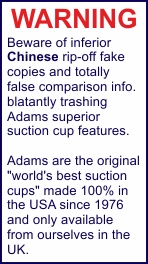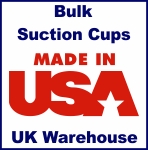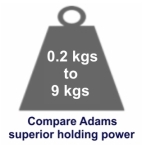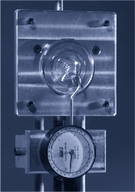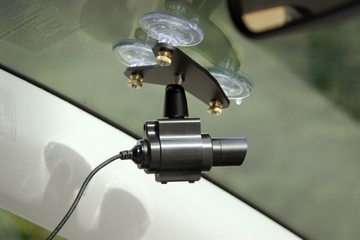How suction cups or suckers work. Adams Suction hooks versus Snap Lock lever types.
Imagine that everything and everybody on earth is completely surrounded by an ocean of air which puts pressure on both the inside and outside of everything.
Gravity pulls the molecules in the air towards earth, creating an atmospheric pressure of roughly 14.7 pounds per square inch at sea level, which acts in all directions. When a suction cup is pushed onto a glossy, non textured, non porous surface, the air underneath is expelled and a vacuum is created. As there is now no air pressure acting under the suction cup, only atmospheric pressure is being applied to the outside of the cup, so pushing it down onto the surface. A good suction cup on a slick surface, causes that pressure to be applied to the outside of the suction cup and pushes it down. Friction keeps the suction cup from sliding.
Air can eventually leak back under the cup (so equalising the air pressure again) especially with a cheap suction cup, but higher quality made Adams suction cups dramatically slows downs this process and they perform better for longer.
By further adding a quick release tab to remove or re-position (as seen on most of Adams suction cups), this eliminates the damage to the suction cup edge caused by the "finger nail removal picking action" on cheap suction cups.
Visit our home page to see why companies choose Adams suction cups at Suction Cups Direct for their requirements.
Be sure to read:- Why Adams World's Best
Adams Suction Hooks versus Snap Lock lever types.
Adams suction cups with hooks hold better than an equivalent size of a "snap lock" lever type suction hook. Snap lock levers pre-load the cup with the mechanism inside the snap device, resulting in a greater pressure differential between the outside and underside of the suction cup. This allows the air to migrate faster as it is reliant only on the suction cup edge for a seal when the mechanism raises the centre of the suction cup away from the fixing surface.
Adams suction cups lie completely flat in a restful manner with their total surface area (including the edge) acting on the glass.
Suitable Surfaces and General Application Tips.
1. Fix suction cups dry, to clean, flat, smooth, slick/shiny, non-porous, non-textured surfaces like glass, mirrors, glossy plastic, glazed ceramic tiles, car bodywork etc. Always test suction cups are suitable before hanging valuable or fragile items.
2. Make sure the suction cup is clean and free from debris.
3. If the suction cup needs to be cleaned, wash in warm soapy water, rinse, then dry gently with a lint-free cloth.
4. Clean the surface you are applying the suction cup to with soap and water. It won't adhere well to a dirty surface. De-grease the applied surface with alcohol if necessary and do not clean the surface with bathroom/window cleaners as they usually leave a residue which will affect adhesion.
5. Press the cup all the way down, against the surface.
6. The suction cup may need to be "burped" periodically by pressing down on it to remove any air that may have seeped in.
There are some newer suction cups on the market that use a sticky substance applied around the outside lip of the cup in order to adhere to non-porous surfaces. We recommend against using these. In our testing,we have found that these cups can potentially damage sensitive surfaces (such as peeling off paint), or can leave behind sticky residue that may be difficult to remove.
 £0
£0